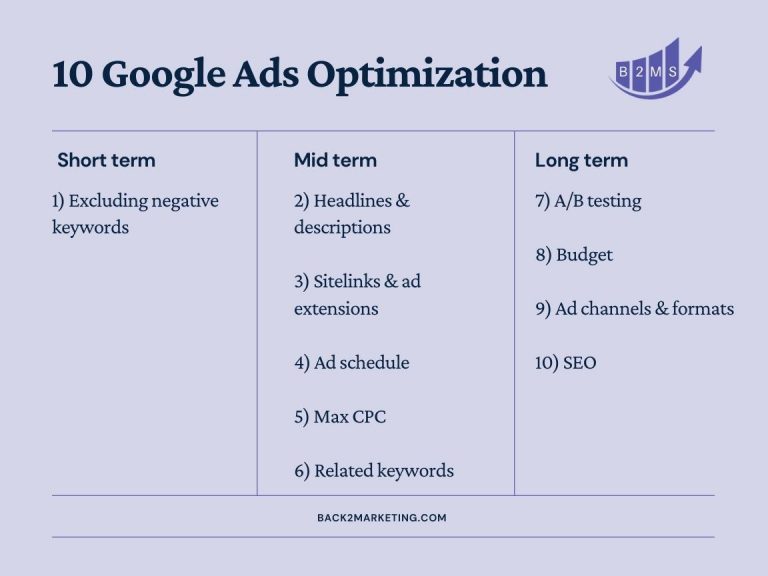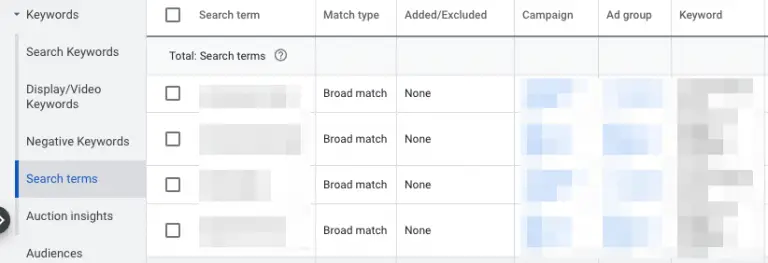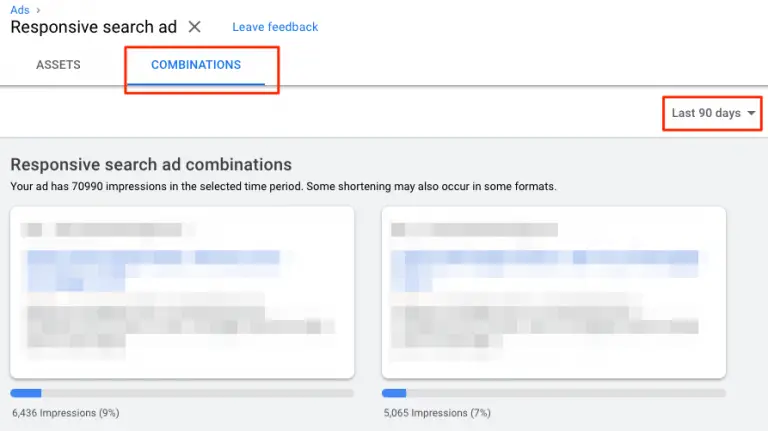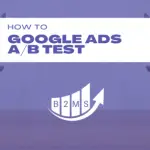10 Google Ads Optimization Tips
Google Ads can be created and optimized at different levels. I look at optimization in the time horizon (short, mid, and long-term) although all optimizations have long-term valid adjustments. It’s more about when the optimizations are made.
Also, as an independent Google Ads Consultant, I strongly advise against using Google’s Smart Campaigns and doing the creation and optimizations on your own.

Short term Google Ads optimization
In the first 14 days, I probably make the most adjustments to a campaign or ad group. Mainly, I adjust negative keywords and match types.
1. Exclusing negative keywords
After just a few days, I look at the actual search terms of a Google Ads search campaign:
Keywords -> Search terms

It is important to understand the difference between keywords and search terms. Keywords in Google Ads are the keywords on which bids and ads are placed. Search terms are the actual search queries entered by the user and matched to a keyword.
To get a better understanding of the search terms, I am also adding the keyword to the above view. To do this, I first need to adjust the columns.
To identify negative keywords, I go through each search term and see if any irrelevant terms were included. If so, I exclude the keywords from the campaign by adding them to the negative keyword list.
Common examples of keywords to exclude are terms like jobs, internship, free, or information-seeking terms like “what is …”.
Another optimization option is to adjust the keyword match type. If a keyword matched many irrelevant search terms, I also narrow down the term from broad to phrase matching.
On the other hand, I also add more keywords to the campaign if a gap becomes apparent.
Mid term adjustments
In the mid term – after collecting some data – further adjustments can be made.
2. Optimize headlines and descriptions of search ads
Headlines and descriptions are important to the success of a Google Ads campaign. I usually use Responsive Ads since Google does an outstanding job with compiling ad assets. However, before I can make adjustments, I need to know which assets or combinations work, and which don’t. I can see this information in the asset details:
Ads & extensions -> Ads -> View asset details:

In the asset details overview, unfortunately, you can’t see a CTR, only the number of impressions and a performance estimate from Google.

In the view of the combinations, I also see only the impressions. We have to trust Google to display the best possible combinations.
Anyway, I pay attention to redundant combinations. For example, if I am a car dealer in Miami and I create the following three headline variations, but I don’t want them to be shown in the same ad:
Top Car Dealers Miami
Miami’s Best Car Dealer
Car Dealership Miami
However, if I see a redundant combination, I turn off the asset with the fewest impressions.

In addition, I usually test several Google Ads versions per ad group, in order to not rely on a single ad copy.
3. Sitelinks and ad extensions optimization
Sitelinks and extensions are another optimization opportunity. For each extension as well as individual sitelinks, I am shown the number of impressions, clicks, and thus click-through rate. For the sitelinks even the conversion according to my settings will be displayed.
4. Adjust ad schedule
Initially, it is uncertain when your ads are most effective. Should ads be shown on weekends for B2B campaigns? Should ads be found when my brick-and-mortar store is closed? These questions can only be answered by data:
In the left main navigation Show More -> Ad schedule -> Day & hour:

Here I can view all interactions broken down to each full hour per day. If certain times are already excluded, they are not displayed here.
If this is too overwhelming for you, you can also view only the days or hours. However, this is only recommended to get a first impression, for example, to answer the question about weekends or after closing time.
However, it may be that Saturday mornings perform best, but over the entire day, Saturday underperforms. Therefore, the day & time overview should always be selected at the end to validate exclusions.
These can then be set in the ad schedule. However, you don’t exclude times but rather apply the time frames when your ads should run.
5. Maximum CPC
Not every keyword costs the same. Certain keywords are more competitive and have higher bids than others. If your bidding strategy is based on clicks (i.e. not conversions), you can set the maximum bid price per keyword. This is useful for nice-to-have or very expensive keywords.
But what should my maximum cost-per-click be?
First, you should know your maximum acquisition cost and also collect some data to calculate conversion rates. I recommend a backward calculation to calculate the advertising budget in the best possible way.
Also, individual average CPCs and CPA (cost of conversions in Google Ads) should be considered. Certain keywords convert better and are therefore more valuable than others.
With the focus on conversions, a target CPA can optionally be entered, which will control the spending.
Learn more about different CPX marketing models here.
6. Test suitable keywords
Based on previous performance of keyword categories or even missing categories, I keep adding more keywords to test further. Please note, however, that more keywords for the same budget mean that each keyword can generate fewer clicks overall. The budget is spread across all keywords. I can control and manage my budget through the previous point, but I should keep an eye on the number of keywords in relation to the budget.
Partly, Google’s keyword recommendations are very helpful. However, these should also be critically questioned and only added if they make sense for the campaign goal.
Long-term Google Ads optimization
After some time – 3 to 6 months – depending on the collected data and after implementing the previously outlined optimizations, I test and adjust long-term optimization opportunities.
7. A/B Testing
Google Ads allows A/B testing for different settings and areas. In successful campaigns, I mostly test the landing pages. Within the successful Google Ads campaign, I can make optimizations only to a certain extent. However, it is also important to consider the entire user flow. Increasing the landing page conversion rate by just half a percentage point from 1% to 1.5% can make a huge difference in return on marketing investment (ROMI).
In addition to landing pages, entire ad groups or bid strategies can also be A/B tested.
Here is a complete guide to conducting Google Ads experiments.
8. Budget optimization
My approach to ad budgets is very simple. I believe you can always scale when you’ve found your winning formula. Of course, you need enough budget to test and optimize quickly but I see budgets not on a monthly scope but rather a total campaign budget and ease my way into higher expenses.
Google Ads has two helpful forecast tools. In the Keyword Planner, budgets can already be projected during campaign planning. For active campaigns, the budget simulator can also be used at the campaign level.
Campaigns -> Campaign budget simulator

You get similar insights when you adjust the daily budget. An amount is immediately suggested and its possible effects are displayed.
9. Other advertising channels and formats
In the long run, I am also testing other advertising channels and types of digital ads. The most common formats are social media ads, but also remarketing ads through Google’s display network. I remarket to the gained website visitors of my performing search ad campaigns.
10. SEO
Often considered in isolation and forgotten are the optimization opportunities for organic search results (SEO). Above all, through Google Ads, many keywords can be tested very quickly in terms of performance.
In the long run, I try to include keywords with a high conversion rate in my SEO strategy. In addition, I can learn a lot about the actual search terms (see #1 adjustment of negative keywords in short-term optimization).
Google Ads campaign goals
Even if it sometimes seems complicated and often requires a somewhat complex setup, the focus should always be on conversions as a campaign goal. Google independently optimizes bids and ad texts (combinations of Responsive Ads) for conversion goals.
Therefore, custom goals should be set up:
Tools & Settings -> Measurement -> Conversions
It is recommended to use the Google Ads Conversion Pixel or Google Analytics goal settings.

Sascha is a Lifecycle Marketing Consultant with over 8 years of digital marketing experiences in Silicon Valley, the UK, and Germany.
After leading the demand generation for a 100+ million company, he decided to venture out on himself. He’s now helping clients to attract and convert more leads and customers.
His main focus are SEO, paid media & marketing automation – all with the focus to tie marketing campaigns to revenue.
Sascha has been featured in industry publications.




